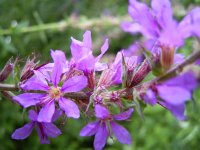Derbennik ivolistny - lythrum salicaria l.
Family Derbennikovye - Lythraceae
Botanical characteristics. Perennial herbaceous plant. Root is woody, thick. Stem erect, up to 1.5 m in height, covered with short hard hairs. The lower leaves are opposite or in whorls of 3 or 4, the upper regular. All the leaves are sessile, almost cordate at the base, pointed at the apex. Flowers crimson, on pedicels, collected whorls at the top of the stem and lateral branches, forming a long discontinuous racemose-spicate inflorescence. Fruit is an oval capsule. Blossoms in July, bears fruit in August.
Spread. It grows along the banks of rivers, among aquatic vegetation, in thickets of willow-bush, in marshes, sometimes near the sea.
Used parts of the plant. Medicinal raw materials are roots, the aerial part of the plant, flowers, leaves, collected in the usual way.
Chemical composition. The plant contains flavonoids, tannins, phenolic carboxylic acids (chlorogenic, gallic, ellagic), essential oil, vitamins. Flowers contain anthocyanins, in the roots - saponins.
Application. In folk medicine decoctions of roots are used as an anti-inflammatory agent for colds, cough, antibacterial, astringent, diuric, analgesic and wound healing. They are used for dysentery, gastralgia, headache, as an antidote for snake bites, encephalitis mites, poisonous and rabid animals, for sexually transmitted diseases, toxicoses in pregnant women, with convulsions. Fresh leaves are applied to bruises, wounds.
Infusions of the aerial part of the derbennik are used as a tonic, restorative, hemostatic, for the treatment of chronic inflammation of the mucous membranes of the organs, gastrointestinal tract and upper respiratory tract; With nervous diseases, epilepsy, rheumatism, hematuria, typhoid, hemorrhoids, whites; Externally - for bathing children, weakened after illness and with increased excitement; Are effective in varicose ulcers, cracks, with eczema, for the treatment of wounds and bruises.
In Japan, derbennik widely used for making drinks that quench thirst. In Tibetan medicine, various nerve diseases are treated. In homeopathy - as a fixative.
Preparation
- To get the broth take 20 g of raw materials, pour 200 ml of boiling water, insist on a boiling water bath for 30 minutes, cool for 10 minutes, filter. Take 1/3 cup 3 times a day, regardless of food intake.
- To infuse 15 grams of leaves, flowers or a mixture of them, pour 180 ml of boiling water, insist on a boiling water bath for 15 minutes, cool for 45 minutes, strain and take 1/3 cup 3-4 times a day.





Comments
When commenting on, remember that the content and tone of your message can hurt the feelings of real people, show respect and tolerance to your interlocutors even if you do not share their opinion, your behavior in the conditions of freedom of expression and anonymity provided by the Internet, changes Not only virtual, but also the real world. All comments are hidden from the index, spam is controlled.